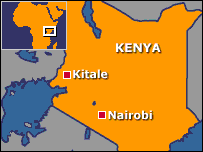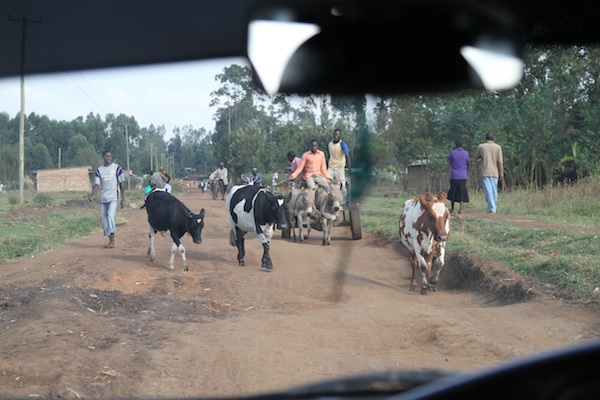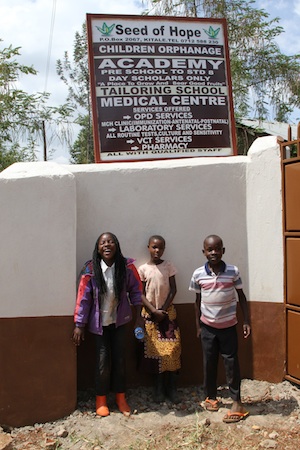Seed of Hope - Kitale, Kenya
 Monday, December 20, 2010 at 08:20PM
Monday, December 20, 2010 at 08:20PM Kitale, a smallish town located in far western Kenya, is home to the Seed of Hope Orphanage.
 Kitale is an agricultural town, surrounded by hundreds (thousands?) of small farm plots ("shambas" in Swahili) and fewer, larger operations. Our visit, in December, coincides with the tail end of the yearly maize harvest, and many people are busy sifting, spreading and drying the corn. Piles of cobs sit here and there, waiting to be sold as fire "wood." As best I can determine, the economy here depends on maize, although the strategy of a once-yearly harvest makes the area susceptible to 1) famine and 2) price gouging. This year, however, the harvest appears robust.
Kitale is an agricultural town, surrounded by hundreds (thousands?) of small farm plots ("shambas" in Swahili) and fewer, larger operations. Our visit, in December, coincides with the tail end of the yearly maize harvest, and many people are busy sifting, spreading and drying the corn. Piles of cobs sit here and there, waiting to be sold as fire "wood." As best I can determine, the economy here depends on maize, although the strategy of a once-yearly harvest makes the area susceptible to 1) famine and 2) price gouging. This year, however, the harvest appears robust.
The pace in Kitale is much, much slower than in Nairobi. However, to my American eyes it still comes across as somewhat chaotic. As elsewhere (everywhere?) in Kenya, there is a steady stream of people, bicycles, motorcycles, carts, donkeys, goats, cars, trucks and vans along each road. Vendors crowd the strips of land adjacent to the road, selling all manner of goods and food. Near the center of town, a large market is permanently in place, where hundreds of merchants offer clothes, shoes, bags, fabric, carvings...just about anything that can be sold. People are busy going to and fro, trying to make a living. For such a "slow" village, Kitale is certainly a lively place from my point of view.
 To reach the Seed of Hope Orphanage, our car travels along the main road through Kitale, and then heads out of town to the west. A short distance further, we turn right onto a dirt road. And what a road it is. Gigantic ruts, dips and gouges serve as constant obstacles, forcing our driver to creep forward, wincing each time the car's undercarriage jams against the road. People, cows and motorcycles pass us, equally slow and deliberate in their progress. The rain is great for the maize, not so much for roads as this.
To reach the Seed of Hope Orphanage, our car travels along the main road through Kitale, and then heads out of town to the west. A short distance further, we turn right onto a dirt road. And what a road it is. Gigantic ruts, dips and gouges serve as constant obstacles, forcing our driver to creep forward, wincing each time the car's undercarriage jams against the road. People, cows and motorcycles pass us, equally slow and deliberate in their progress. The rain is great for the maize, not so much for roads as this.
Shortly, we pass the church and school used by the Seed of Hope, the Seed of Hope Academy. We turn left onto a long, straight Kenyan road, lined by small huts and tin-roofed homes. Groups of huts designate family compounds called "bomas," and several bomas line the road to the orphanage.
 Soon enough, we reach the Seed of Hope Orphanage. The compound is marked by a new gate, new paint and a new sign. The gate swings open and we pull into the compound, a grassy lot containing several buildings, a small playground, two water wells, a grain storage building, a tractor and trailer, and a seating area protected by a thatch shade. Overall, it is a very pleasant place.
Soon enough, we reach the Seed of Hope Orphanage. The compound is marked by a new gate, new paint and a new sign. The gate swings open and we pull into the compound, a grassy lot containing several buildings, a small playground, two water wells, a grain storage building, a tractor and trailer, and a seating area protected by a thatch shade. Overall, it is a very pleasant place.
The reason we're there, of course, is the kids. Oh, the kids! As it is the break between school years, there are not as many kids present as is typical (although orphans, many of the kids do have relatives to visit over the break). However, many of the kids I've come to know and love are present, and they come to us the second we step out of the car. Sharon, Heron, Farida, Christine, Caren, Linah...all these kids and more surround us and welcome us back. This moment, this specific time of reunion and joy, is indescribably sweet.
We've only a short time to visit, less than 24 hours, so we waste no time in greeting the kids and visiting the staff. Also present is a small group of Germans, including the founder of the orphanage, Carsten Werner. His is a fascinating story, which you can read here.
Carsten and the others make us feel welcome, share their lunch with us, and soon we're all sitting in the shade, laughing and sharing stories. Carsten, who is phenomonally good with children, begins to plan a stroll to visit the cows. (The Seed of Hope recently moved to a zero-grazing system for their three cows, but still puts them in a field on occasion.)
The short stroll is a hoot. We move down the road, about 25 of us, greeting the local families and children. We make quite a spectacle, I'm sure. We make our way to the cows, who seem to be doing great, and listen as Carsten explains some of the details of the grazing and Seed of Hope maize crops. Apparently, the Seed of Hope is trying to get a second maize crop and is, thus far, quite successful. After spending some time with the cows, we make our way back to the compound for tea. ("Taking tea" in Kenya is one of the greatest joys in life, I'm convinced.)
Afterwards, Carsten motions for everyone to make their way to the Dining Hall building...apparently the kids and staff were going to gather for some sort of performance. Having been here before, I figured it would include lots of singing, and I was right. What followed was about 45 minutes of praise and worship, mostly singing.
How can I describe such a time? Worship stripped of all bells and whistles...no drum kits, no guitars, no light shows, no song leader in strategically torn jeans and hair gel. Nothing but the passionate, resounding voices of a few people praising God. And what people? People who have so little compared to us Americans, people who sometimes struggle to eat and survive and stay healthy. People who go without the very basics of life at times. Yet, these people truly love God. They find the blessings in their life, they find ways to be thankful. How much I learn from these kind, genuine people!
Knowing who these people are, and understanding somewhat how they live, I can't help but be moved, humbled and inspired by them as they sing "let your will be done." Enjoy.

